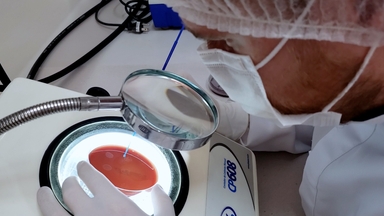A Dye Release Assay to Quantify Enzymatic Activity of Antimicrobial Proteins
Transcript
Begin with a tube containing heat-killed bacterial suspension and treat with a dye solution.
The dye molecules covalently bind to the peptidoglycan — an essential component of the bacterial cell wall, imparting a blue coloration.
Pellet the bacteria and remove the supernatant containing unbound dye molecules.
Resuspend the bacteria and introduce an antimicrobial protein solution to the tube, triggering enzymatic hydrolysis of the bacterial peptidoglycan, resulting in cell wall degradation followed by cell lysis.
This leads to the release of the dye molecules, imparting blue coloration.
Add ethanol — a protein denaturing agent, inactivating the antimicrobial proteins and terminating the enzymatic reaction.
Centrifuge the contents to pellet the cell fragments and enzymes. Transfer the dye molecule-containing supernatant to a multi-well plate.
Using a plate reader, measure the absorbance at 595 nanometers.
Compare the absorbance of the enzyme-treated sample with that of the enzyme-untreated sample to quantify the enzymatic activity of the antimicrobial protein.
Related Videos

Use of the Soft-agar Overlay Technique to Screen for Bacterially Produced Inhibitory Compounds (Video) | JoVE

Systematic Approach to Identify Novel Antimicrobial and Antibiofilm Molecules from Plants' Extracts and Fractions to Prevent Dental Caries (Video) | JoVE

Rapid Antimicrobial Susceptibility Testing by Stimulated Raman Scattering Imaging of Deuterium Incorporation in a Single Bacterium (Video) | JoVE
ABOUT JoVE
Copyright © 2024 MyJoVE Corporation. All rights reserved